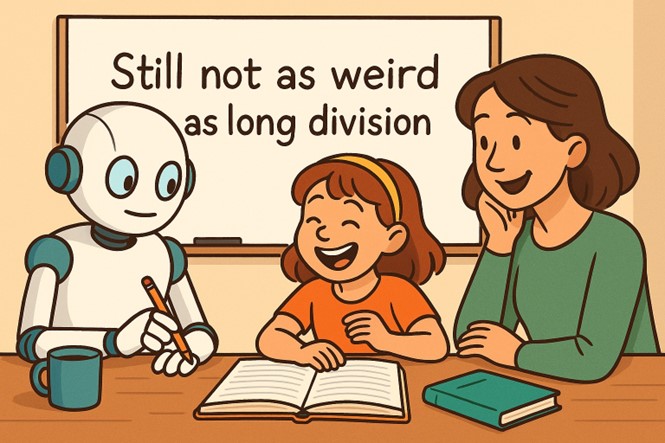More Parents Are Using AI – But Who’s Pulling Who?
Recent surveys show that parents are more likely to be regular users of AI than non-parents. What the surveys don’t reveal is why.
Are parents embracing AI to give their children a head start – or are they being dragged along, kicking and screaming, by tech-savvy kids who’ve already made friends with ChatGPT?
Either way, one thing’s clear – AI isn’t just for techies anymore. It’s becoming a part of everyday family life – from helping with homework to settling dinner-table debates. (Yes, giraffes really do sleep standing up – mostly.)
If you’re already confident with AI, feel free to carry on without us – but if you’re just starting to explore what it can do, you’re in the right place. Let’s get you up to speed – quickly and painlessly. We’ll start by answering some quick-fire questions
Why Use It?
AI in education acts like a helpful tutor – offering explanations, answering questions, and adapting to each child’s needs. It supports teachers by reinforcing learning and giving instant, personalised help whenever it’s needed.
And the best bit? It never rolls its eyes, gets tired of spelling “photosynthesis”, or says, “We didn’t learn it like that in my day.”
Is It Safe For Children?
Absolutely – if you go to the right place – we’ll tell you more about that later
Is there More than One AI?
Yes – the best known ones are Gemini (developed by Google) and ChatGPT (developed by Open AI). There are several others but let’s not get bogged down with them just now.
Do I Need to Download Anything?
Not usually – most AI tools run in your web browser. No cables, no updates, no fuss.
Do I Need to Pay for It?
Some versions are free, others offer extra features if you pay – but there’s plenty you can try without spending a penny.
Can It Help with All Subjects?
Pretty much – from maths and science to history, geography, and even creative writing. It’s like having a subject expert on call.
Will It Replace Teachers?
Nope – and it shouldn’t. AI is a great helper, not a human substitute. Think support act, not headliner.
What If It Gets Things Wrong?
It sometimes does – so a pinch of healthy scepticism is wise. Just like with Wikipedia, it’s smart to double-check important stuff.
Can It Make Learning More Fun?
Yes! Ask it to explain things with jokes, limericks, pirate voices or dinosaur facts – you’ll be amazed what it comes up with.
Which AI to Use
We unreservedly recommend ChatGPT – it’s by far the most popular. To remember “GPT” think Great Parenting Tool or, if you really want to impress your friends, use the techie language – Generative Pre-trained Transformer!
Getting Started
Here is what ChatGPT responded when I told it “Please give me instructions to start using ChatGPT and explain it like I’m a 5-year-old”
- Open a computer, tablet or phone.
- Go to openai.com (that’s where ChatGPT lives!).
- You might need to sign up (that means tell it your name and email, like saying “Hi, it’s me!”).
- Now you’re ready! You’ll see a box that says something like “Send a message…” or “Ask me anything!”
- Just type what you want to ask. Like:
- 🧒 “Why is the sky blue?”
🧒 “Tell me a silly joke!”
🧒 “Can you help with my homework?”
🧒 “Write a story about a dragon who eats pancakes.” - Then press Enter or click the little arrow ▶️
I like to think of ChatGPT as a very clever Alexa. Chat with it, experiment, make it your friend. It never loses patience, never gets offended, never judges your spelling or ideas and never, ever shouts, sulks or storms off!
Something even quicker?

Visit any quiz on the Education Quizzes website and click on the image – you’ll be using AI in the blink of an eye.
Written by Colin King, co-founder and owner of Education Quizzes – a UK-based platform offering teacher-written revision quizzes that have built-in Safe AI Tutoring.


